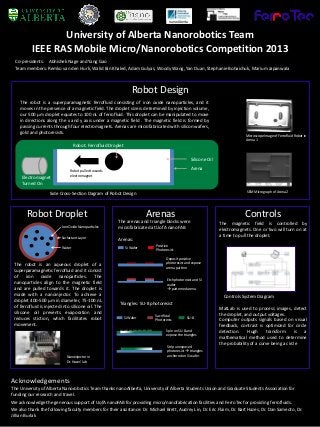
Competition Poster PDF
- 1. University of Alberta Nanorobotics Team IEEE RAS Mobile Micro/Nanorobotics Competition 2013 Co-presidents: Abhishek Nage and Yang Gao Team members: Remko van den Hurk, Walid Bin Khaled, Adam Gulyas, Woody Wang, Yan Duan, Stephanie Bohaichuk, Marium Japanwala Acknowledgements The University of Alberta Nanorobotics Team thanks nanoAlberta, University of Alberta Students Union and Graduate Students Association for funding our research and travel. We acknowledge the generous support of UofA nanoFAB for providing micro/nanofabrication facilities and FerroTec for providing ferrofluids. We also thank the following faculty members for their assistance: Dr. Michael Brett, Audrey Lin, Dr. Eric Flaim, Dr. Bart Hazes, Dr. Dan Sameoto, Dr. Jillian Buriak nanoAlberta Robot Droplet Arenas Controls Robot Design Iron Oxide Nanoparticles Surfactant Layer Water The robot is an aqueous droplet of a superparamagnetic ferrofluid and it consist of iron oxide nanoparticles. The nanoparticles align to the magnetic field and are pulled towards it. The droplet is made with a nanoinjector. To achieve a droplet 400-500 µm in diameter, 75-100 nL of ferrofluid is injected into silicone oil. The silicone oil prevents evaporation and reduces stiction, which facilitates robot movement. Nanoinjector in Dr. Hazes’ lab The robot is a superparamagnetic ferrofluid consisting of iron oxide nanoparticles, and it moves in the presence of a magnetic field. The droplet size is determined by injection volume, our 500 µm droplet equates to 100 nL of ferrofluid. This droplet can be manipulated to move in directions along the x and y axis under a magnetic field . The magnetic field is formed by passing currents through four electromagnets. Arenas are microfabricated with silicon wafers, gold and photoresists. Microscope Image of Ferrofluid Robot in Arena 1 Side Cross-Section Dagram of Robot Design SEM Micrograph of Arena 2 Silicone Oil Arena Robot: Ferrofluid Droplet Electromagnet Turned On Robot pulled towards electromagnet Controls System Diagram MatLab is used to process images, detect the droplet, and output voltages. Computer outputs signals based on visual feedback, contrast is optimized for circle detection. Hugh transform is a mathematical method used to determine the probability of a curve being a circle Triangles: SU-8 photoresist The arenas and triangle blocks were microfabricated at UofA nanoFAB Arenas: Si Wafer Positive Photoresist Si Wafer Sacrificial Photorests SU-8 Spin on SU-8 and expose the triangles Strip unexposed photoresist triangles anchored on Si wafer Deposit positive photoresist and expose arena pattern Etch photoresist and Si wafer patterned arena The magnetic field is controlled by electromagnets. One or two will turn on at a time to pull the droplet.